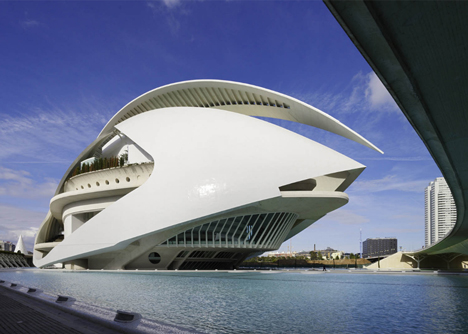Santiago Calatrava wins legal battle against "insulting and degrading" website
trumpets The Guardian newspaper, parroted by the archipop sites like Dezeen.
I've been keeping a draft post on architects and court cases for a while, but it probably won't see the light of day. Not because I am scared of being sued. Rather, I keep putting off publishing because it genuinely is difficult to research the status and the outcomes of litigation so that one fairly reports who is at fault for what.
There is no such difficulty here. Santiago Calatrava sued the left wing opposition party sponsored website, which has carried on a relentless, barefisted campaign against the wastefullness of the Valencia city government - as exemplified by the extremely expensive Ciudad de las Artes y las Ciencias de Valencia (City of Arts and Sciences) complex. The web site claimed Calatrava had billed the local government €100 million in fees alone, adding that he was "bleeding Valencia dry".
Calatrava won.
Actually, he won €30,000 in damages, and an order that the web site display the court's verdict. Given the star architect had sued for €600,000, one would conclude the judge didn't think that the damage to his reputation was substantial. In practice, rather more damaging is the sting in the judgement, now ordered by the Spanish court to be publicly displayed:
It was the name of the site that was a bit too clever: Calatravatelaclava.com loosely translates as 'Calatrava bleeds you dry', which apparently is a bit of an exaggeration when describing the €100 million, that the city's most famous son has reputedly earned on the project.The judge found that the web site had published "objective truths" and that the information on it was "within the limits of the criticism" in relation to freedom of expression.
As reported in Dezeen, Calatrava
has recently been involved in a number of other disputes in Spain:
In April
2013 the owners of the Calatrava-designed Ysios winery in the La Rioja
region of Spain launched legal action against the architect over
a leaky roof, demanding a contribution to the £1.7 million required for its
repair after repeated attempts by Calatrava's builders to fix the problem. In June
2013, he paid €3.3 million to settle a dispute after a conference
centre he designed in the northern Spanish city of Oviedo suffered structural
collapse. In
Bilbao, his footbridge to the Guggenheim has caused controversy after the city
had to pay compensation to pedestrians who slipped on its glass surface in wet
weather. Not just injury, but insult: the differential thermal movement of the large glass elements has led to them cracking, raking up a substantial replacement bill for the city. I understand in desperation they have laid out a rubber mat over the glass.
At least an
investigation into a problem with the roof of the Palau de les Arts Reina
Sofia opera house in the City of Arts and
Sciences did end favourably for Calatrava. The sections
of mosaic on the facade of the building which came away in high winds last
winter were the fault of a
subcontractor responsible for the application of adhesive used to secure the
mosaic tiles.
But the starchitect's legal problems are not confined to Spain. The PATH Transportation Center at
Ground Zero in Lower Manhattan is more than 6 years late and is now
costing U$4 billion, more than twice as much as its initial budget. Venice
is suing Calatrava and several engineers for huge cost overruns and
excessive need for repairs on his Ponte della Costituzione, a footbridge
across Venice’s Grand Canal. A regional court has ordered him
to pay back more than a million and a half dollars in fees.
One does start to wonder. As Mark Favermann at Berkshite Fine Arts comments, not quite every starchitect is constantly embroiled in court cases over, apparently, careless design or detailing of egomaniacal projects. Mind you, the only exception he could come up with, with a fair degree of confidence, was Lord Foster, the self-professed Steve Jobs of Architecture. Faverman also raises the obvious, but opposite question: Maybe, it's worth it to pay these exorbitant sums, for buildings that don't work, but might be the masterpieces of an age?
I am in two minds, but tend to come down on the side of "I don't think so". Especially in this week when we watched in dread, as Charles Rennie Mackintosh's quirky 'kind grandfather' of a building, the Glasgow School of Art burned.
Read the Guardian's Top Spanish architect wins lawsuit over 'Calatrava bleeds you dry' website.

No comments:
Post a Comment